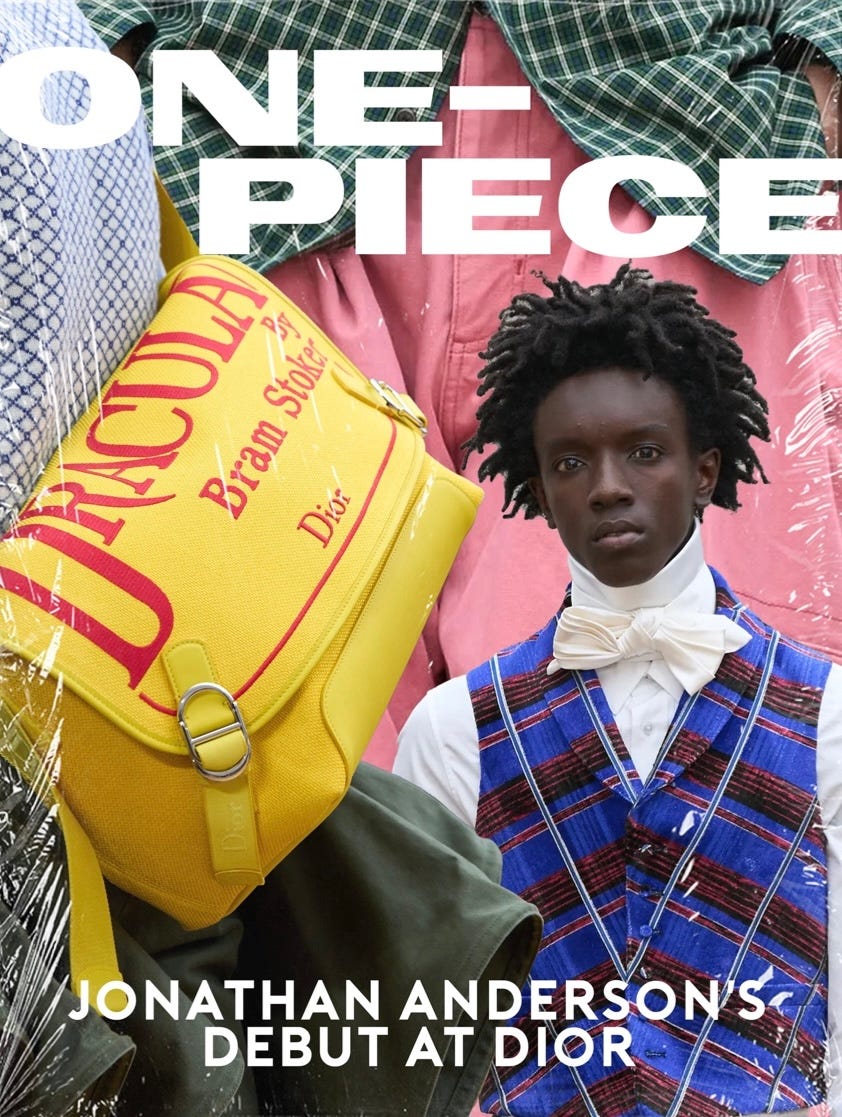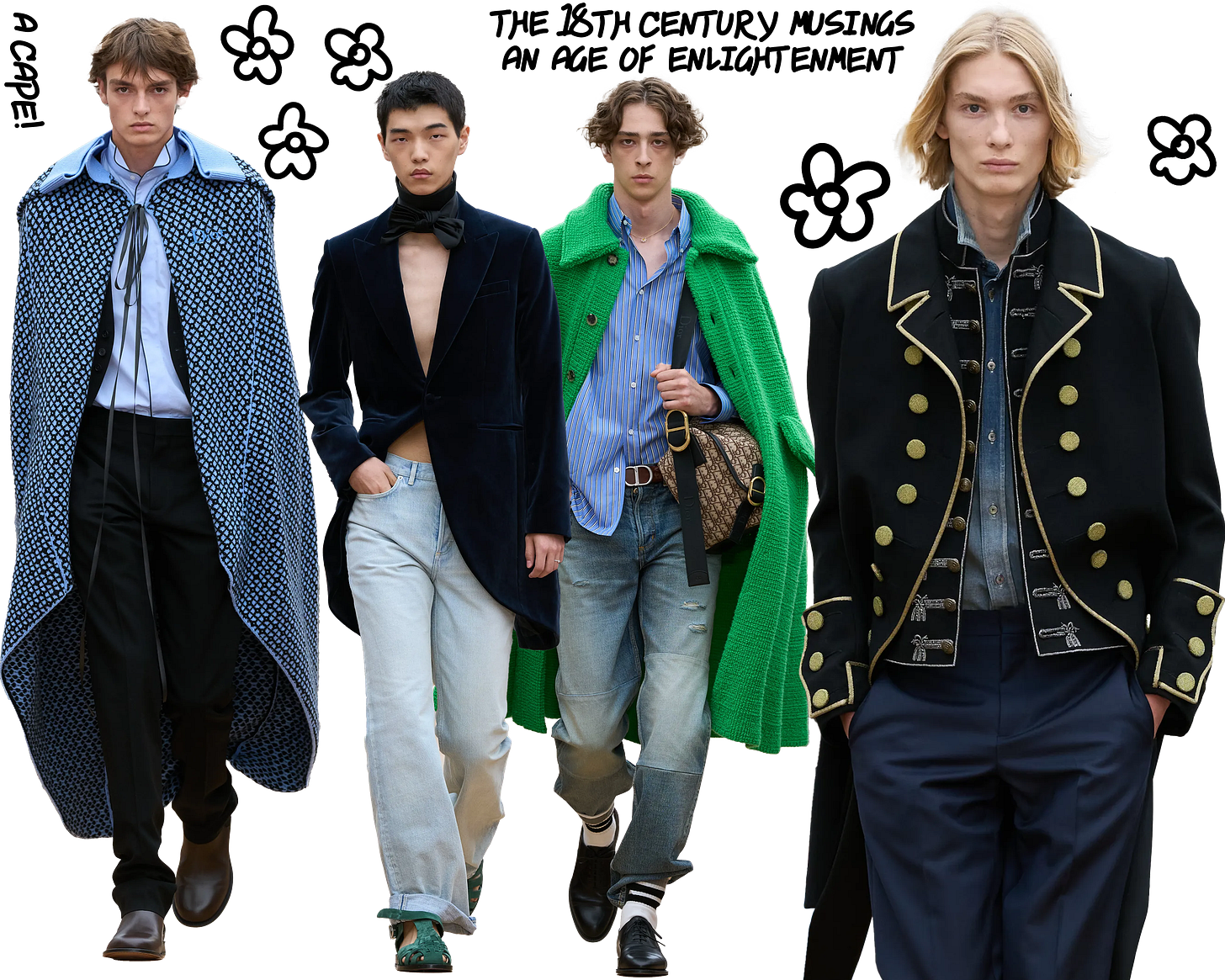Jonathan Anderson's SS26 Debut at Dior
The master of the arts finally begins his reign as Creative Director of my favourite Parisian fashion house.
Every fashion lover has been waiting with bated breath for Jonathan Anderson’s debut with the house of Dior. The buildup was exciting! It felt as if people who didn’t usually involve themselves with fashion week had noticed that history was being made with this show and had decided to take an interest.
It became an event: Luca Guadaningo was seen interviewing guests upon their arrival. Thousands of people tuned in from across the world for the live stream. Elias Medini held a viewing party that overflowed onto the streets of Paris. Keyboard warriors even began posting their live reviews before the show had begun, as muses of Anderson’s Dior arrived in the yet-to-be-seen runway pieces.
It’s now Tuesday, July 1st, and every one of my social apps’ newsfeeds or timelines is still talking about Anderson’s Dior SS26 collection, which debuted on Friday. Although when one becomes the first designer since Christian Dior himself to have control of women’s, men’s and couture collections, I too would not—and have not—stop talking about the occasion.
Expectations Ahead of the Show
Our first glimpse into Jonathan Anderson’s Spring/Summer 2026 collection for Dior began with the new book totes, which were direct literary references—extremely cool.
There were also portraits of Lee Radziwill and Jean-Michel Basquiat by Andy Warhol posted by both Dior and Jonathan Anderson on Instagram. Karen Binns, global fashion director of 10 magazine, spoke about Basquiat’s effortless style and her excitement to learn about Anderson using him as a muse for the collection in Dior’s podcast. She mentions that “Jonathan [Anderson] said Jean has everything to do with Dior because he is the epitome of style.”
A few days before the collection’s debut, Finacial Times posted an article written from an interview with Delphine Arnault, the CEO of Dior and the eldest child of LVMH chair and chief executive Bernard Arnault, where she said “The next five years is going to be all about quality in the materials and the manufacturing. Quality is key.” That doesn’t necessarily say ‘fashion forward’. However, when you’ve elected Jonathan Anderson, a designer who, like Dries Van Noten, doesn’t follow trends but rather creates them, to head up the direction of the entire house, then we can still expect to see something deeply nuanced and unique.
Additionally, coming from a brand like Loewe, which prioritises quality and craftsmanship, quality and manufacturing may already be second nature for Anderson.
The SS26 Runway Collection
As the first model made his way onto the runway, it was clear that this Dior was different. It also felt very familiar—a testament to the research and history Jonathan Anderson embeds in his work. Everything he does has layers, references and meanings. Anderson’s Dior SS26 is young, without ostracising other generations, it draws on Monsieur Dior’s original designs and fabrics, and it is like nothing we’ve seen before.
There’s an immediate nod to the 18th century, an era Christian Dior himself was enamoured by. Anderson drew inspiration from this period by recreating a series of embroidered and frogged waistcoats and jackets in black, beige, and mint. He also modernised the frock coat and made capes, in vibrant hues of green and blue, creating a coveted piece of fashion in menswear (which, in my opinion, it has never been).
Styled under these modernised takes from the Age of Enlightenment are jeans and shorts. Bowties are tied against wrapped collars that sit over bare chests. It’s here that I can visibly see Anderson decode and recode the foundations of Dior. There’s a playful shift toward a loosened formality, the mix of high and low charm we’ve come to love in his work.
Another highlight of the SS26 collection is the shorts with the looping bustle. You’ve all seen them by now, but might not know that the idea was lifted from Monsieur Dior’s ‘Delft’ dress from 1948. It was known for its dramatic fabric manipulation and its architectural and structural folds.
The second style of shorts seen in the collection references the 1952 ‘La Cigale’ dress, another archival piece from Christian Dior that plays with volume by exaggerating body proportions as it balloons outwards from the hips. The bodice of ‘La Cigale’ has also been reinterpreted through the structure and fabrication of a dusty lavender vest jacket in the collection, and the dress’s neckline is matched in the white knit seen on Sam Nivola, who attended the runway show wearing Anderson’s Dior.
“The Cigale, for me, I think it’s one of my favourite dresses in history. I was never going to start Dior without referring to it because it is one of the greatest feats of engineering in terms of a dress,” Anderson tells BOF backstage after the show.
In the same conversation, Anderson mentions that every fabric in the collection has been revived from the archives of Christian Dior's tenure. If they’re not revived, they’re fabrics that are new to the fashion house.
I find there is magic in these recontextualisations of menswear, where womenswear and femininity have become the base on which menswear is built on. It’s the form of masculinity being reinterpreted and broken down, again and again, to make room for new identities. The constant reshuffling of rules is what I love about menswear fashion.
One thing I did not like in the show was the rolled-up, raspberry-pink, roomy, straight-leg chinos, which unfortunately appeared more than once. It reminded me of the only pants I found hanging on the racks in accessible ($$) stores as a fashion-loving teenager. It makes me feel creatively restricted. I’d like to see that style of pants expunged from the earth. Though I suppose this is more of a comment about myself than the design.
And for that one dislike, I had only love for everything else: the multicoloured blue tartan vest over a white shirt with the signature bowtie motif of the collection. The wide denim jeans and cargo pants with a fabricated spiral winding down the leg. The “thrown on” button-up shirts with messy collars and patterned ties. Fitted sweaters with the new (old) Dior logo elegantly placed at the hip.
With the heavy references to Monsieur Dior and his archives, the original Dior salon, and the house’s codes alongside Anderson’s signatures—his love for art and oddity—it’s hard to believe that this is a debut collection. Perhaps it’s because when it comes to the House of Dior, there's already a long history to play with and relate to, but with the height of that rich legacy, there's more room to fall, which Anderson has not.
From the backstage conversation with BOF, Anderson spoke about his plan for Dior. “I want to go through a series of five shows, which will each show different aspects of the brand,” he says.
“Some will contradict it, some will go along with it, and some will completely radical from it. So couture may be a different exercise than the men’s. For me, this is the beginning point; it is establishing a language. You do not lock yourself in from the beginning. For me, it is why I wanted something which was very fluent within itself. So that you can kind of grow from here, ultimately.”
The new era of Dior feels like it might be its best yet. SS26 is an amalgamation of history, archival pieces and classic codes that have been recreated by a master of the arts. I cannot wait to see where we go from here.
The Accessories
As a self-proclaimed bag and shoe enthusiast, I had to dedicate a special section of this substack to the new accessories on the runway. And as someone who also rarely wears shoes with the laces done up, Anderson’s new Dior sneaker, slouchy and messy, felt like a handwritten letter addressed from him to me. Already, this collection feels is personal.
My accessory love affair with SS26 began with the oblique print messenger bag with the gold CD initial logo hardware on the straps. It then moved toward the new iteration of the Lady Dior bag, the first in a men's collection, nestled in a cascade of tassels. Amy Odell called them “pure linen ponytails.” The bag is designed in collaboration with artist Sheila Hicks, famous for her experimental and colourful weavings and sculptural textile art.
This is an obvious choice for me, but my heart keeps coming back to the new book totes that feature direct literary references—an idea that I can hardly believe Dior hasn’t explored sooner. Bram Stoker’s ‘Dracula’ with red type on a bright yellow canvas in both a satchel messenger (I’m desperate for this) and the classic book tote form. There’s also Christian Dior’s biogrpahy ‘Dior by Dior’, Capote’s ‘In Cold Blood’, Sagan’s ‘Hello Sadness’ and Baudelair’s ‘The Flowers of Evil’.
Interestingly, some of the titles chosen for the book totes were featured in AnOther magazine’s interview with Jonathan Anderson back in 2017, where he shares a list of his formative literary tomes. Like Kim Jones, books are essential to Anderson, but I’m happy that we get to see a direct visual representation of this in his work.
The font of the new Dior logo, notably featured in the iterations of the book totes mentioned, uses the same typeface as when Christian Dior established his house. At the time, everything was done by block printing and type, which naturally have imperfections as each letter was carved or made by hand. Anderson has touched up some of the imperfections but has also kept a few. In the BOF video, he says, “In couture, there’s always perfection, but there’s always something slightly off.”
Thank you for reading my opinions on and about my love of fashion. Did you know, Dior was my very first love in the luxury fashion space? Hey, that story might make a good newsletter! Better subscribe now so you can read it first!












The In Cold Blood tote is a tad sinister 🤣